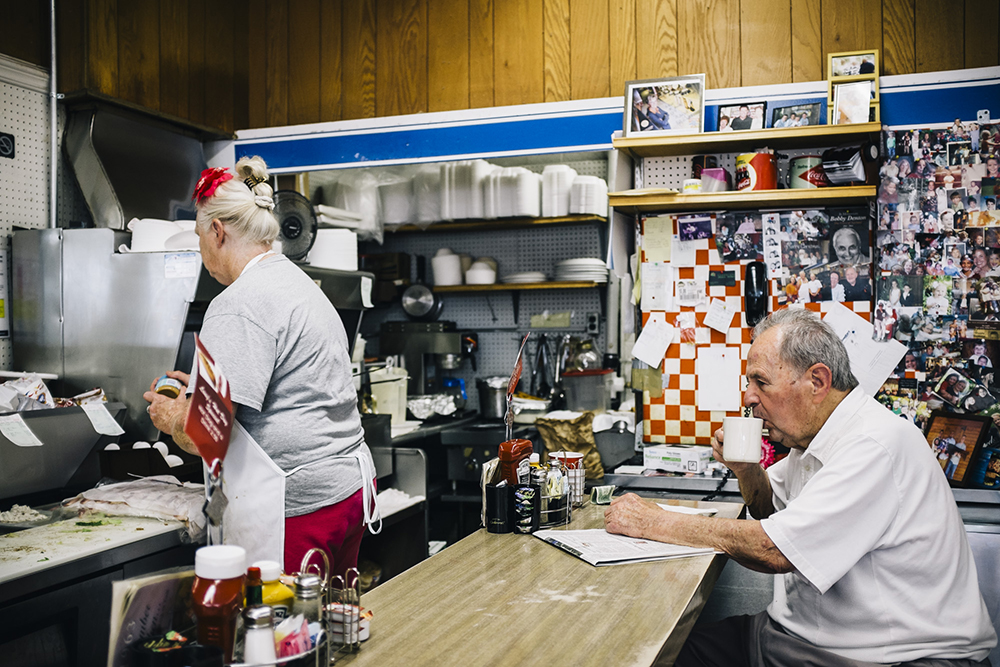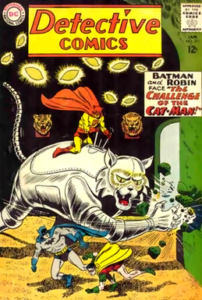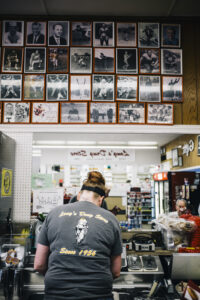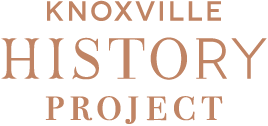Has the closing of a drugstore in a suburban strip center ever been the cause of so much grief?
From the outside, it looked like nothing special. Sometime in the 1980s, the 1956 shopping center underwent a modernizing facelift, as if to convince people driving by on Kingston Pike that “there’s nothing to see here, just another strip mall, keep moving please.” But the interior didn’t change much. It was the same place created during the Eisenhower administration by Clarence Long, the beloved pharmacist who had previously worked at Ellis & Ernest, adjacent to UT campus. Mr. Long died in a car wreck on Kingston Pike in 1966, but his place kept his name and its character for decades to come, its legacy respected by management and clientele.
Maybe we should have taken it as a clue that Long’s was such a rarity, the very last of the original generation of soda-fountain drugstores, that it wouldn’t last. It’s been something to brag about, and hear visitors say, “Wow, we don’t have anything like this at home.” Obviously most corporate pharmacies gave up on that model decades ago. There’s no CVS lunch counter. Most Americans in 2024 aren’t old enough to even remember when a practical, unpretentious lunch counter was a standard amenity in any retail setting. It worked once. I’m not sure why it doesn’t still. It’s not my business.
The news stories detailing the closing of Long’s have been mainly about the impossibility of small business competing with the corporate pharmaceutical industry, and that’s hard to doubt.
Since about 1962, I’ve been to Long’s several hundred times. Perhaps it’s even in the thousands, because there was a spell in the early ‘70s, when it was on my bicycle paper route, that I went to Long’s literally every day. But in all that time, I’ve never picked up a prescription there. Most of the times I’ve ever been to Long’s were during my blissfully prescription-free youth. I do have prescriptions now, but without ever making a deliberate choice that I remember, I found myself picking them up at night at one of the big chains that were still open when I was off work.
My point is that, for most of us who have loved it, Long’s has been something much more than, or something entirely other than, a pharmacy. They acknowledged that with their longtime motto: “Meet me at Long’s.” Maybe some people do socialize while waiting for a prescription; I’ve never been able to make that work.
But Long’s contained multitudes. It was once, among other things, my favorite place to eat.
I learned early on that they could make almost anything back there on those gleaming machines behind the counter. You could challenge those ladies to make something with soda water and cherry and ice cream and cola and chocolate syrup that had never been done before. Sometime in the late ‘60s, when I got them to mix some cherry syrup into my Coke, I was convinced that we had, together, invented Cherry Coke. It was the perfect counterbalance to a BLT or a grilled cheese and onion rings with mustard.
I sometimes saw detectives and other cool characters on TV walk into a bar and say, “the usual.” Long’s is the only place I ever said “the usual” and made it work. My usual was a cherry Coke and onion rings, with some mustard on the side. Sometimes I’d add a sandwich to it, but only if a larger person was handy to pay for it.

Long’s Drugstore by Shawn Poynter for the Knoxville Mercury, 2015.
Over the years I learned much about our language and civilization at Long’s Drugstore. One of the things I learned was the meaning of the word Sundries. It was legible high on a wall, part of the old décor. For years, I thought Sun-dries were exotic colorful desserts maybe imported from tropical climes.
In fact, sundries just means “lots of random stuff.” Long’s sold toys, lotions, magazines, modest gifts, paperback novels, Kleenex, postage stamps, cigars, decorative bric-a-brac.
The whole back of the lunch-counter region was a toy emporium, an ever-changing pageant of affordable delights. Big bags of assorted plastic army men to replenish those forces chewed up by the dog, blown up with firecrackers, or lost in backyard cave-ins. Yo-yos, both Duncan and cheaper models. Baseball cards. Bicycle playing cards. Superballs, when they were amazing and new and quickly lost. Bolo paddles, Groucho glasses and other novelties. In 1964, shortly after the Beatles were on Ed Sullivan, you could find authentic Beatles wigs, packaged in plastic bags like strange evidence, hanging among the toys at Long’s. Fan that I was, the wigs were a little too weird even for me. But if I’d bought one and didn’t open it, today I could sell it on ebay for a few hundred dollars.
What I bought more than anything, and I bet I bought 40 or 50 of them over the years, were balsa-wood airplanes with rubber-band propellors. Both the simple hand-thrown Skeeters but also the more-expensive—I think they were 29 cents—models that had wheels and given a concrete runway would take off by themselves, and occasionally even land safely. They thrilled me, even though I always thought I was putting them together wrong. Printed on each one was the instruction “Bend Oregon,” and I never could figure out what the oregon was. But they seemed to work fine without my bending it.
And all that right by the comic books, 20 or 30 different issues, a different array of them every week or two.
***
When I visited Paris, 40-odd years ago, one of my biggest surprises was a retail establishment right on the Champs-Elysee called Le Drugstore. They’re kind of like a drugstore on drugs. Everything you think of in an American drugstore was exaggerated there.
The people who created it were enthralled by the wonderful new American ideal of the Drugstore, a place where young people would hang out and brag and flirt and get a Coke and some fries. It has evolved into a semi-fancy restaurant. They sell fashions, perfume, groceries, magazines, cigars.
I first saw it when I was 22, and I thought of Long’s. Le Drugstore took the idea of “sundries” to a whole different level. I haven’t been to Paris in 43 years, but I checked, and Le Drugstore is still there today, and a big deal. If it’s not tres chic, it’s tres something.
It dates back to 1960, an era when the retail lunch counter seemed modern, practical, American.
But Le Drugstore is now old, itself, almost old as Long’s, and maybe old enough to be considered historic, except that it’s in a city where several restaurants and cafes are old enough to recall the era when Zelda Fitzgerald and George Gershwin and Jean-Paul Sartre were customers. Paris has several cafes, like the Deux Magots and Le Flores, that are 200 years old.
We don’t love anything quite that much.
***
Among the many other things it was, Long’s was also, arguably, the oldest sit-down restaurant in Knoxville, a city that generally does not reward its culinary heritage with longevity. Several American cities sustain century-old restaurants. But we have only one or two that General Neyland, if revived after a 60-year nap, would recognize.
The world’s favorite cities support their old businesses, and seem to need them. But antiquity is the one thing even the most progressive mayor and city council and the most resourceful millionaires and business leaders can’t provide. So we keep letting things close, always noting something about keeping up with changing times, and the impossibility of going on with an old-fashioned business model. And we have to start all over again with what we have left.
With Long’s closed, what’s now Knoxville’s oldest same-name, same-location restaurant? Maybe the 1960 Pizza Palace, on Magnolia Avenue: even if it’s a drive-in. Most of its customers eat in their own cars—I’m often one of them—and don’t encounter anyone but the waitress. But after that, what’s next in line? When I first began writing about Knoxville, there were more than a dozen distinctive locally owned unpretentious neighborhood cafes that seemed to play a role as community gathering places. Dot’s, the Roman Room, the Amber, the Torch, the Quarterback, Wright’s, the Creamery, Ruby’s, Henderson’s, Dixson’s, Ott’s, the Court Café, the Southern Grill, Smoky Mountain Market, Glenwood Sandwich Shop; and Long’s. Those are all old-line places that have closed since the ‘90s.
Today, people do meet at one particular Waffle House or other. But almost all Knoxville restaurants that have been around for more than 50 years are national chains. What does that say about us?
***
If Long’s is the oldest restaurant in town, it may also be the least expensive. Seriously, I don’t know anywhere in Knoxville where you can enjoy a satisfying sit-down meal, with table service, for less than $5. You might expect to find the cheapest restaurant in the cheapest part of town, but I’ve sought many lunches in the cheaper parts of town, and I’m not sure anyone compares to Long’s for thrift.
Long’s is on the fringe of Sequoyah Hills and Lyons View, and many of its most regular patrons are millionaires, and the rituals and conventions of posh can get tiresome. Maybe they’re seeking refuge in a simple chicken-salad sandwich and fries.
***
Over the years Long’s has been through some unwelcome changes that may have been inevitable. One was Styrofoam. It began showing up at Long’s sometime late in the last century. I was told it was a practical necessity to get by modern health codes because they didn’t have room for a high-performance dishwasher. I hate Styrofoam, but I loved Long’s more. I learned I could avoid it by just getting a glass-bottle Coke from the cooler.
Covid seemed to knock Long’s off balance, as it did so many good things. When I was there alone, which was often, I used to sit mainly at the counter, rubbing elbows with polite strangers. But at some point after Covid, Long’s closed their counter. They never called it permanent, but it stayed closed. As of last year the waitresses were wondering when they’d relent and reopen it.

Issue #311, 1963. (Wikipedia.)
Most catastrophic, years before all that, was the loss of the comic-book rack. That was, of course, a national grief. It’s a tragic irony worthy of Lex Luthor: it was just as we were getting $100 million blockbuster-movie adaptations of Batman, Superman, and Spiderman that the actual comic books that kids loved—they were generally a dime or a quarter—disappeared from our world. It was those slim little stapled magazines, Action and Detective Comics and Tales of Suspense, that introduced superheros to our planet and laid out the basic rules of the universes in which they operated. I first heard of Batman, Superman, Spiderman, the Thing, the Flash, the Green Lantern, and Iron Man, among many others, at the comic-book rack in that one room called Long’s.
Some comics survived as “graphic novels,” but they were sold at specialty boutiques, not from racks in drugstores. And they seemed far too dark and melodramatic and expensive ever to be nearly as much fun as the rarely published “World’s Finest” issues, packed with multiple stories new and old, so thick they had a spine. To this day, grownups pay live-concert money to see superhero movies based on cheap comic books that were aimed at elementary-school kids with a dime who devoured them at Long’s lunch counter, free from care about whether they were stained with cola and ketchup.
At the same time I was learning the fascinating rules of Bizarro World and the comparative risks of the various grades of Kryptonite, I was still reading Uncle Scrooge, Disney’s most interesting printed product. By age 10 I was not always happy for peers to catch me at Long’s counter reading about ducks, they were nonetheless irresistible, stories often more clever than Detective Comics, always entailing some sort of brightly colorful adventure to a faraway place, and more often than not with a coherent plot with sideways moral and a surprising but perfect ending, usually with Scrooge and his hyperactive nephews landing exactly as they were at the beginning of the tale.

Long’s Drugstore by Shawn Poynter for the Knoxville Mercury, 2015.
Long’s also sold some paperbacks, detective and romance novels but not just that. The erstwhile drugstore served some of us as an introduction to Western Civilization. I was about 11 when I bought—at Long’s—a little paperback called The Wisdom and Ideas of Plato. When I saw it there, it seemed more compelling than any textbook. I was pretty sure it would make me the wisest of all sixth-graders. I did read part of it. I have every intention of finishing it, maybe this month.
Somehow, even without the comics and wisdom for sale, I kept going to Long’s. Less often in recent years. One reason I sometimes paused before a Long’s visit was that even in the 21st century, it was often very crowded. About 20 or 30 years ago, I used to take my family there on Saturdays. It was just a bit of weekly fun that a reporter could afford. But as years passed, sometimes we had to wait, standing, for half an hour before a table opened. So we just stopped going.
But in the years since, Long’s has become more a solo weekday whim. I’d pop in only when it wasn’t a conventional breakfast or lunchtime, and when I happened to be in the neighborhood on a Tuesday morning, say, or a Thursday afternoon.
A lunch at Long’s was kind of like touching home plate. Is there another place that serves that purpose now? If so, let me know about it.
By Jack Neely







Leave a reply